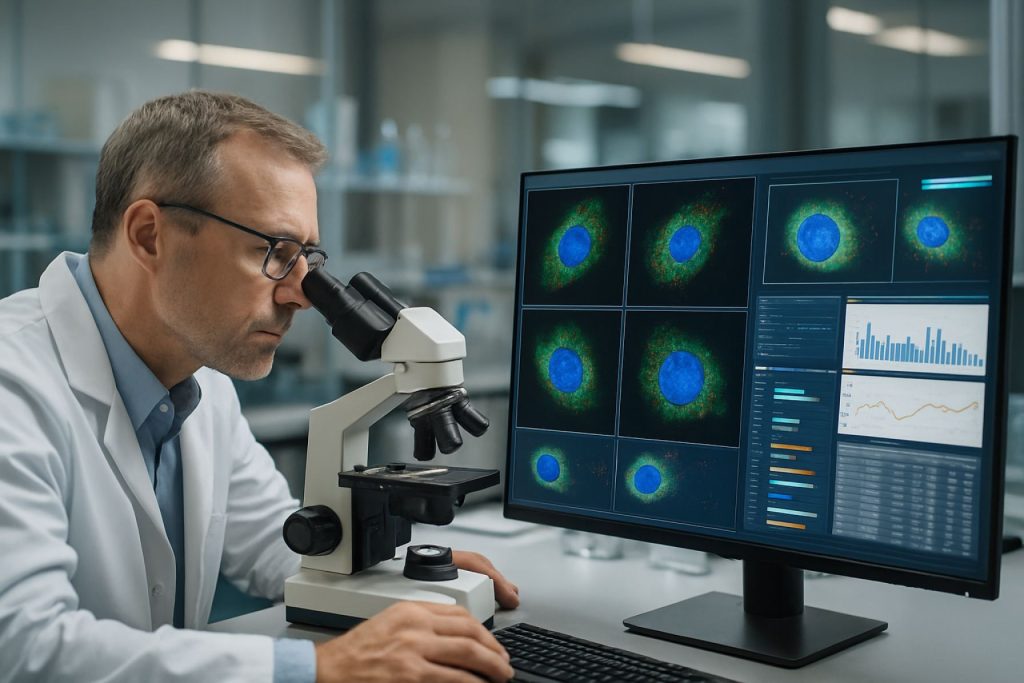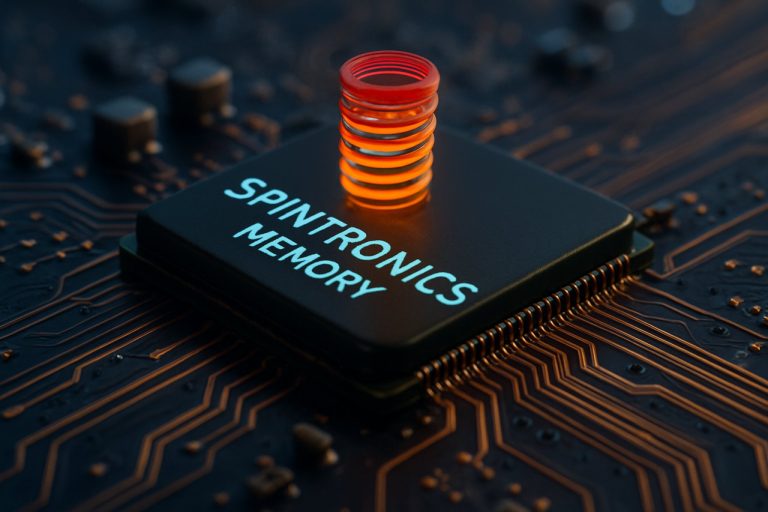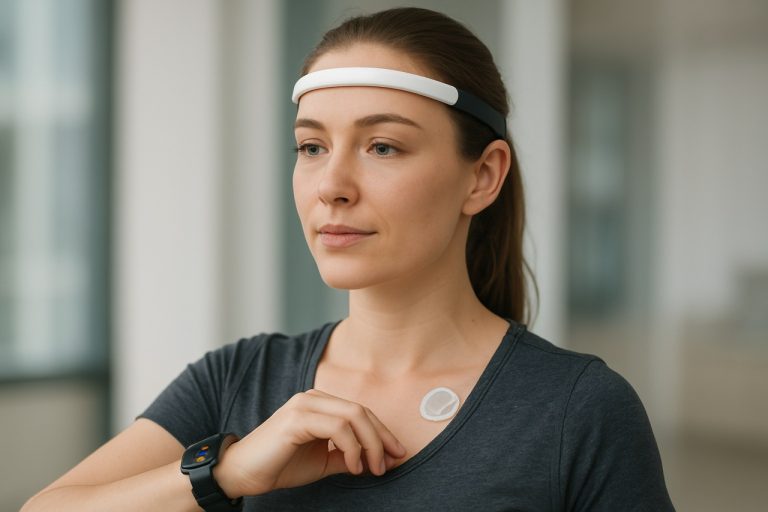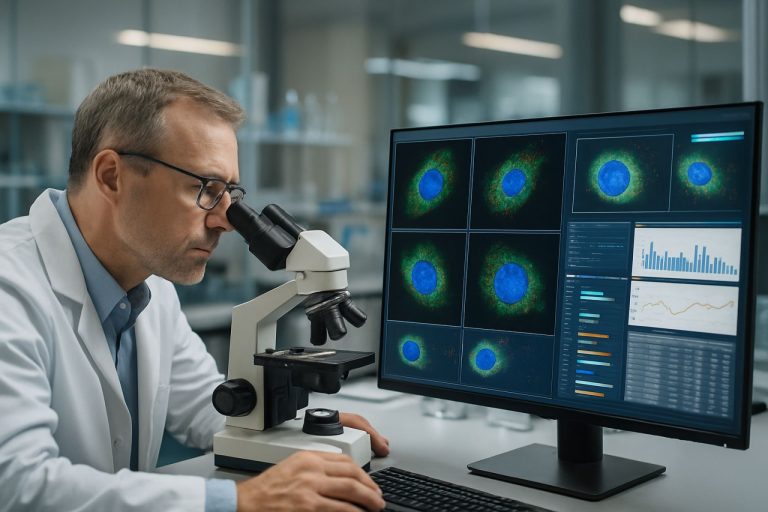
Revolutionizing Single-Cell Analysis: How High-Content Workflow Automation Will Transform Research and Diagnostics in 2025 and Beyond. Explore the Technologies, Market Forces, and Strategic Opportunities Shaping the Next Era.
- Executive Summary: Key Trends and Market Drivers in 2025
- Technology Landscape: Innovations in High-Content Workflow Automation
- Market Size and Forecast: 2025–2030 Growth Projections
- Leading Players and Strategic Partnerships
- Integration with AI and Machine Learning: Accelerating Single-Cell Insights
- Regulatory Environment and Standardization Efforts
- Adoption Barriers and Solutions: From Lab to Clinic
- Case Studies: Breakthrough Applications in Research and Diagnostics
- Competitive Analysis: Differentiators and Emerging Entrants
- Future Outlook: Strategic Opportunities and Long-Term Impact
- Sources & References
Executive Summary: Key Trends and Market Drivers in 2025
High-content workflow automation for single-cell analysis is rapidly transforming the landscape of cellular research and precision medicine in 2025. The convergence of advanced robotics, microfluidics, and artificial intelligence (AI) is enabling unprecedented throughput, reproducibility, and data richness in single-cell studies. This section highlights the key trends and market drivers shaping the sector in 2025 and the near future.
- Integration of Robotics and AI: Automated platforms are now central to single-cell workflows, minimizing manual intervention and human error. Leading instrument manufacturers such as Thermo Fisher Scientific and Beckman Coulter Life Sciences have expanded their portfolios with robotic liquid handlers and AI-driven image analysis tools, enabling high-throughput, reproducible single-cell assays.
- Advances in Microfluidics and Sample Preparation: Microfluidic technologies are streamlining cell isolation, lysis, and reagent delivery, supporting scalable and gentle processing of thousands to millions of cells per run. Companies like Standard BioTools (formerly Fluidigm) and Dolomite Microfluidics are at the forefront, offering modular systems that integrate seamlessly with downstream analytical platforms.
- Multiplexed and Multimodal Analysis: The demand for deeper biological insights is driving the adoption of platforms capable of simultaneous measurement of transcriptomics, proteomics, and epigenomics at the single-cell level. 10x Genomics continues to lead with its Chromium platform, while BD Biosciences and Miltenyi Biotec are expanding their high-content cytometry and sample preparation solutions.
- Cloud-Based Data Management and Analysis: The explosion of single-cell data is fueling demand for scalable, secure, and collaborative informatics solutions. Cloud-enabled platforms from Illumina and Agilent Technologies are facilitating real-time data processing, sharing, and AI-powered analytics, accelerating discovery cycles.
- Regulatory and Clinical Adoption: As single-cell technologies mature, regulatory bodies are providing clearer guidance for clinical applications, particularly in oncology and immunology. This is catalyzing investment in automated, GMP-compliant workflows and driving partnerships between technology providers and clinical laboratories.
Looking ahead, the market for high-content workflow automation in single-cell analysis is expected to see robust growth, propelled by the need for scalable solutions in drug discovery, biomarker development, and personalized medicine. The next few years will likely witness further convergence of automation, AI, and multi-omics, with industry leaders and emerging innovators shaping the competitive landscape.
Technology Landscape: Innovations in High-Content Workflow Automation
High-content workflow automation for single-cell analysis is rapidly transforming the landscape of cellular research, driven by the convergence of advanced imaging, microfluidics, robotics, and artificial intelligence. As of 2025, the sector is witnessing a surge in integrated platforms that streamline the entire single-cell analysis pipeline—from sample preparation and cell isolation to high-throughput imaging, data acquisition, and computational analysis.
Key industry players are at the forefront of these innovations. PerkinElmer has expanded its Opera Phenix and Harmony platforms, integrating automated liquid handling and high-content imaging to enable robust, reproducible single-cell workflows. These systems are designed to handle large sample volumes with minimal manual intervention, reducing variability and increasing throughput. Similarly, Sartorius has advanced its Incucyte and iQue platforms, focusing on real-time, automated imaging and analysis of live cells, which is critical for dynamic single-cell studies.
Another major contributor, Thermo Fisher Scientific, continues to innovate with its Attune CytPix and CellInsight systems, which combine flow cytometry, high-content imaging, and automated data processing. These platforms are increasingly being integrated with cloud-based informatics, allowing for scalable data storage and AI-driven analytics. Miltenyi Biotec is also notable for its MACSQuant and MACSima platforms, which automate cell sorting and multiplexed imaging, respectively, supporting high-dimensional single-cell analysis with minimal user input.
Microfluidics-based automation is another area of rapid development. Standard BioTools (formerly Fluidigm) and Dolomite Microfluidics are pushing the boundaries of single-cell partitioning and reagent delivery, enabling precise, scalable workflows for genomics and proteomics at the single-cell level. These systems are increasingly being adopted in translational research and clinical settings, where reproducibility and throughput are paramount.
Looking ahead, the next few years are expected to bring further convergence of automation, AI, and multi-omics capabilities. Companies are investing in machine learning algorithms for automated image analysis and cell classification, as well as in cloud-based platforms for collaborative data sharing and interpretation. The integration of robotics for sample handling and preparation is anticipated to further reduce hands-on time and error rates, making high-content single-cell analysis more accessible to a broader range of laboratories.
Overall, the technology landscape in 2025 is characterized by a shift toward fully automated, end-to-end solutions that promise to accelerate discovery in fields ranging from immunology and oncology to regenerative medicine and drug development.
Market Size and Forecast: 2025–2030 Growth Projections
The market for high-content workflow automation in single-cell analysis is poised for robust growth between 2025 and 2030, driven by accelerating adoption in pharmaceutical research, clinical diagnostics, and biotechnology. The increasing complexity of single-cell experiments, coupled with the need for higher throughput and reproducibility, is pushing laboratories to invest in integrated automation solutions that streamline sample preparation, imaging, data acquisition, and analysis.
Key industry players such as Thermo Fisher Scientific, PerkinElmer, Sartorius, and BD (Becton, Dickinson and Company) are expanding their portfolios with advanced platforms that combine robotics, microfluidics, and artificial intelligence-driven analytics. For example, Thermo Fisher Scientific’s automation solutions are increasingly integrated with their single-cell sequencing and imaging systems, enabling end-to-end workflows that reduce manual intervention and error rates. Similarly, PerkinElmer’s high-content screening platforms are being enhanced with machine learning algorithms to accelerate phenotypic profiling at the single-cell level.
The demand for scalable, high-throughput single-cell analysis is further fueled by large-scale initiatives in precision medicine and immuno-oncology, where the ability to process thousands of samples with minimal hands-on time is critical. Sartorius, through its acquisition of companies specializing in cell analysis and automation, is positioning itself as a leader in providing modular, scalable solutions for both research and clinical laboratories. BD continues to innovate in flow cytometry and cell sorting automation, supporting the growing need for standardized, reproducible single-cell workflows.
From a regional perspective, North America and Europe are expected to maintain their dominance due to strong investments in life sciences infrastructure and early adoption of automation technologies. However, Asia-Pacific is projected to witness the fastest growth, driven by expanding biopharmaceutical manufacturing and increasing government funding for genomics and cell biology research.
Looking ahead to 2030, the market outlook remains highly positive. The convergence of high-content imaging, next-generation sequencing, and cloud-based data management is expected to further accelerate automation adoption. Industry leaders are investing in open, interoperable platforms that facilitate seamless integration across hardware and software ecosystems, lowering barriers for smaller laboratories to implement advanced single-cell workflows. As a result, the high-content workflow automation segment is anticipated to experience double-digit compound annual growth rates through the end of the decade, underpinned by continuous innovation and expanding application areas.
Leading Players and Strategic Partnerships
The landscape of high-content workflow automation for single-cell analysis is rapidly evolving, with leading players leveraging strategic partnerships to accelerate innovation and market reach. As of 2025, several established life science technology companies and emerging specialists are at the forefront, driving the integration of advanced robotics, microfluidics, and artificial intelligence (AI) into single-cell workflows.
Among the global leaders, Thermo Fisher Scientific continues to expand its portfolio of automated platforms, combining high-throughput sample preparation with advanced imaging and data analytics. The company’s collaborations with academic centers and biopharmaceutical firms have resulted in robust, scalable solutions for single-cell genomics and proteomics. Similarly, Becton, Dickinson and Company (BD) has strengthened its position through the development of integrated cell sorting and analysis systems, often partnering with software developers to enhance data interpretation and workflow efficiency.
Another key player, Sartorius, has focused on automating cell isolation and characterization, particularly for applications in cell therapy and immunology. Sartorius’s strategic alliances with biotech startups and research institutes have enabled the co-development of modular platforms that streamline single-cell processing from sample input to multi-omic readouts. Meanwhile, PerkinElmer (now part of Revvity) has invested in high-content imaging and analysis systems, often integrating AI-driven software through partnerships with computational biology firms.
Emerging innovators such as Standard BioTools (formerly Fluidigm) and Miltenyi Biotec are also making significant strides. Standard BioTools has advanced microfluidic-based platforms for single-cell multi-omics, frequently collaborating with pharmaceutical companies to tailor solutions for drug discovery and biomarker identification. Miltenyi Biotec, known for its expertise in magnetic cell separation, has expanded into automated single-cell analysis through joint ventures with instrument manufacturers and software providers.
Strategic partnerships are increasingly central to progress in this sector. For example, alliances between instrument manufacturers and cloud computing providers are enabling seamless data management and remote analysis, while collaborations with AI companies are enhancing the speed and accuracy of single-cell data interpretation. Looking ahead, the next few years are expected to see further consolidation and cross-sector partnerships, as companies seek to offer end-to-end, interoperable solutions that address the growing complexity and scale of single-cell research.
Integration with AI and Machine Learning: Accelerating Single-Cell Insights
The integration of artificial intelligence (AI) and machine learning (ML) with high-content workflow automation is rapidly transforming single-cell analysis, particularly as we move through 2025 and into the coming years. This convergence is enabling unprecedented throughput, accuracy, and depth in the extraction of biological insights from complex cellular datasets. Automated platforms now routinely combine high-content imaging, flow cytometry, and multi-omics data acquisition with advanced computational pipelines, streamlining the entire single-cell workflow from sample preparation to data interpretation.
Key industry players are at the forefront of this transformation. Thermo Fisher Scientific has expanded its automated single-cell platforms, integrating AI-driven image analysis and data management tools to accelerate phenotypic screening and rare cell detection. Their solutions leverage deep learning algorithms to classify cell types and states with minimal human intervention, reducing analysis time and operator bias. Similarly, Becton, Dickinson and Company (BD) has advanced its BD Rhapsody and FACSymphony platforms, incorporating ML-based analytics for high-dimensional flow cytometry and transcriptomics, enabling researchers to uncover subtle cellular heterogeneity and functional states.
Another notable contributor, Sartorius, has focused on integrating AI-powered image analysis into its Incucyte and CellCelector systems, facilitating real-time monitoring and automated selection of single cells for downstream applications. These platforms are increasingly being adopted in pharmaceutical and biotechnology sectors for drug discovery, immuno-oncology, and cell therapy development, where rapid, reproducible, and high-content single-cell data are critical.
The adoption of cloud-based AI platforms is also accelerating. 10x Genomics has introduced cloud-enabled analysis pipelines that utilize ML algorithms for scalable processing of single-cell RNA-seq and spatial transcriptomics data, allowing researchers to handle datasets comprising millions of cells. This approach not only democratizes access to advanced analytics but also supports collaborative research across institutions.
Looking ahead, the next few years are expected to see further integration of AI/ML with robotic automation, enabling end-to-end, hands-free single-cell workflows. Advances in explainable AI will enhance the interpretability of complex models, fostering greater trust and adoption in clinical and translational research. As regulatory agencies begin to recognize the value of AI-driven analytics, standardized frameworks for validation and quality control are anticipated, paving the way for broader clinical implementation of automated single-cell analysis.
In summary, the synergy between high-content workflow automation and AI/ML is poised to accelerate single-cell insights, driving innovation in biomedical research and precision medicine throughout 2025 and beyond.
Regulatory Environment and Standardization Efforts
The regulatory environment and standardization efforts surrounding high-content workflow automation for single-cell analysis are rapidly evolving as the technology matures and adoption accelerates in both research and clinical settings. In 2025, regulatory agencies and industry consortia are increasingly focused on ensuring data quality, reproducibility, and interoperability across platforms, which is critical for the translation of single-cell technologies into diagnostics, therapeutics, and large-scale research initiatives.
Key regulatory bodies such as the U.S. Food and Drug Administration (FDA) and the European Medicines Agency (EMA) are actively engaging with stakeholders to develop guidance documents and frameworks tailored to the unique challenges of single-cell analysis. These include considerations for automated sample preparation, data acquisition, and analysis pipelines, as well as the validation of high-content imaging and sequencing platforms. The FDA, for example, has expanded its engagement with developers of digital health technologies and advanced diagnostics, emphasizing the need for robust validation and traceability in automated workflows.
Industry organizations such as the International Society for Magnetic Resonance in Medicine (ISMRM) and the European Bioinformatics Institute (EMBL-EBI) are contributing to the development of data standards and best practices for single-cell data management and sharing. The EMBL-EBI in particular is involved in initiatives to harmonize metadata standards and promote interoperability between different high-content analysis platforms, which is essential for multi-center studies and regulatory submissions.
On the technology supplier side, leading companies such as Thermo Fisher Scientific, Becton, Dickinson and Company (BD), and Sony Corporation are collaborating with regulatory agencies and standards bodies to ensure their automated single-cell analysis platforms meet emerging compliance requirements. These companies are investing in features such as audit trails, secure data storage, and standardized reporting formats to facilitate regulatory acceptance and streamline the approval process for clinical applications.
Looking ahead, the next few years are expected to see the introduction of more formalized international standards for high-content workflow automation in single-cell analysis, driven by collaborations between regulatory agencies, industry, and academic consortia. This will likely include standardized protocols for instrument calibration, data annotation, and quality control, as well as frameworks for the secure sharing of sensitive single-cell data. As these standards mature, they are anticipated to accelerate the adoption of automated single-cell workflows in regulated environments, supporting the broader integration of single-cell technologies into precision medicine and translational research.
Adoption Barriers and Solutions: From Lab to Clinic
The transition of high-content workflow automation for single-cell analysis from research laboratories to clinical settings is accelerating, yet several adoption barriers persist. As of 2025, the primary challenges include integration with existing laboratory information systems, standardization of protocols, data management complexities, and regulatory compliance. Addressing these issues is critical for realizing the full clinical potential of single-cell technologies.
One significant barrier is the interoperability of automated platforms with diverse laboratory information management systems (LIMS) and electronic health records (EHRs). Many clinical laboratories operate legacy systems that are not readily compatible with the advanced data outputs generated by high-content single-cell platforms. Leading automation providers such as Beckman Coulter Life Sciences and Thermo Fisher Scientific are actively developing middleware and open API solutions to facilitate seamless data exchange and integration, aiming to reduce manual data handling and potential errors.
Standardization remains a pressing concern. Variability in sample preparation, staining protocols, and data analysis pipelines can hinder reproducibility and cross-site comparability. Industry consortia and organizations, including 10x Genomics and Standard BioTools (formerly Fluidigm), are collaborating with regulatory bodies to establish best practices and reference standards for automated single-cell workflows. These efforts are expected to yield harmonized protocols and quality control metrics within the next few years, facilitating broader clinical adoption.
Data management and analysis present another layer of complexity. High-content single-cell platforms generate vast, multidimensional datasets that require robust computational infrastructure and secure storage. Companies such as Illumina and BD (Becton, Dickinson and Company) are investing in cloud-based analytics and AI-driven data interpretation tools to streamline clinical reporting and ensure compliance with data privacy regulations.
Regulatory approval is a final, but formidable, hurdle. Automated single-cell analysis platforms must demonstrate analytical validity, clinical utility, and compliance with standards such as CLIA and IVDR. In response, manufacturers are increasingly engaging in early dialogue with regulatory agencies and participating in pilot clinical studies to generate the necessary evidence for approval. The next few years are likely to see the first wave of fully automated, regulatory-cleared single-cell analysis systems entering clinical diagnostics, driven by ongoing innovation and cross-sector collaboration.
In summary, while adoption barriers remain, the concerted efforts of technology developers, industry consortia, and regulatory bodies are paving the way for high-content workflow automation to become a mainstay in clinical single-cell analysis by the late 2020s.
Case Studies: Breakthrough Applications in Research and Diagnostics
High-content workflow automation for single-cell analysis is rapidly transforming both research and clinical diagnostics, enabling unprecedented throughput, reproducibility, and data richness. In 2025, several case studies highlight the impact of these technologies across diverse applications, from oncology to immunology and regenerative medicine.
One prominent example is the integration of automated high-content imaging and analysis platforms in cancer research. Leading institutions have adopted systems such as the PerkinElmer Opera Phenix Plus and Molecular Devices ImageXpress Confocal HT.ai, which combine automated sample handling, multiplexed fluorescence imaging, and AI-driven image analysis. These platforms have enabled researchers to profile phenotypic heterogeneity in tumor biopsies at single-cell resolution, supporting the identification of rare cell populations associated with drug resistance and metastasis. For example, automated workflows have been used to screen patient-derived organoids for response to immunotherapies, accelerating the development of personalized treatment strategies.
In immunology, high-content automation has facilitated large-scale functional screening of immune cell subsets. The Sartorius CellCelector and Miltenyi Biotec MACSima platforms have been deployed in translational research centers to automate the isolation, imaging, and molecular profiling of single T cells and B cells. These workflows have been instrumental in mapping immune repertoires and discovering novel therapeutic antibodies, with direct implications for vaccine development and autoimmune disease research.
Diagnostics laboratories are also leveraging high-content automation for single-cell analysis in clinical workflows. The Thermo Fisher Scientific Ion Torrent Genexus System, for instance, integrates automated sample preparation, sequencing, and data analysis, enabling rapid single-cell genomic profiling from liquid biopsies. This has improved the detection of minimal residual disease in hematological malignancies and facilitated early intervention strategies.
Looking ahead, the next few years are expected to see further convergence of high-content automation with multi-omics technologies and cloud-based data management. Companies such as 10x Genomics and Standard BioTools (formerly Fluidigm) are expanding their automated platforms to support integrated transcriptomic, proteomic, and epigenomic analyses at single-cell resolution. These advances are anticipated to drive new case studies in developmental biology, neurodegeneration, and infectious disease, as well as to support the implementation of precision diagnostics in routine clinical practice.
- Automated high-content workflows are enabling large-scale, reproducible single-cell studies in oncology, immunology, and diagnostics.
- Key platforms from PerkinElmer, Molecular Devices, Sartorius, Miltenyi Biotec, Thermo Fisher Scientific, 10x Genomics, and Standard BioTools are at the forefront of these advances.
- Future trends include integration with multi-omics, AI-driven analytics, and cloud-based data sharing, expanding the impact of single-cell analysis in both research and clinical settings.
Competitive Analysis: Differentiators and Emerging Entrants
The competitive landscape for high-content workflow automation in single-cell analysis is rapidly evolving as established life science instrumentation companies and innovative startups vie for leadership. The sector is characterized by a convergence of advanced imaging, microfluidics, artificial intelligence (AI), and robotics, all aimed at increasing throughput, reproducibility, and data richness in single-cell studies.
Key differentiators among market leaders include the degree of end-to-end automation, integration of multi-omics capabilities, and the sophistication of data analytics platforms. Thermo Fisher Scientific continues to leverage its broad portfolio, offering automated platforms that combine cell isolation, high-content imaging, and downstream molecular analysis. Their systems are notable for seamless integration with proprietary reagents and informatics, appealing to pharmaceutical and academic users seeking standardized workflows.
PerkinElmer (now rebranded as Revvity) remains a strong competitor, particularly in high-content screening and imaging. Their Opera Phenix and Harmony platforms are widely adopted for automated, multiplexed single-cell imaging, with recent enhancements focusing on AI-driven image analysis and cloud-based data management. Sartorius has expanded its reach through acquisitions and partnerships, integrating microfluidics and real-time analytics into its automated cell analysis systems, targeting both research and bioprocessing applications.
Emerging entrants are disrupting the market with novel approaches. Miltenyi Biotec has introduced microchip-based platforms for high-throughput single-cell sorting and analysis, emphasizing gentle cell handling and compatibility with downstream omics. Mission Bio specializes in single-cell DNA and multi-omics analysis, offering automated workflows that enable simultaneous genotyping and phenotyping at scale. Their Tapestri platform is gaining traction in translational research and clinical settings.
Another notable player, Standard BioTools (formerly Fluidigm), is advancing microfluidic automation for single-cell genomics and proteomics, with a focus on customizable workflows and integration with third-party analytics. Meanwhile, BD (Becton, Dickinson and Company) leverages its expertise in flow cytometry and cell sorting to deliver automated, high-throughput single-cell platforms, increasingly incorporating AI for data interpretation.
Looking ahead to 2025 and beyond, the competitive edge will likely hinge on the ability to deliver fully integrated, user-friendly systems that minimize manual intervention and maximize data quality. Companies investing in open software ecosystems, cloud connectivity, and AI-powered analytics are poised to capture growing demand from both research and clinical markets. As single-cell analysis becomes central to precision medicine and drug discovery, the sector is expected to see further consolidation, strategic partnerships, and the emergence of new entrants leveraging disruptive technologies.
Future Outlook: Strategic Opportunities and Long-Term Impact
The future of high-content workflow automation for single-cell analysis is poised for significant transformation as the field moves into 2025 and beyond. The convergence of advanced robotics, microfluidics, and artificial intelligence (AI) is expected to drive both the scalability and precision of single-cell workflows, enabling researchers to interrogate cellular heterogeneity at unprecedented depth and throughput.
Key industry leaders are investing heavily in integrated platforms that combine automated sample preparation, high-throughput imaging, and multi-omics data acquisition. For example, Thermo Fisher Scientific continues to expand its automation portfolio, focusing on seamless integration of liquid handling, cell sorting, and high-content imaging modules. Similarly, Sartorius is advancing its automated cell analysis systems, emphasizing user-friendly interfaces and cloud-based data management to facilitate collaborative research and remote monitoring.
The adoption of AI-driven analytics is another major trend shaping the future landscape. Companies like PerkinElmer are embedding machine learning algorithms into their high-content screening platforms, enabling real-time image analysis and automated phenotypic classification. This not only accelerates data interpretation but also reduces human error, making large-scale single-cell studies more reliable and reproducible.
Looking ahead, the integration of multi-omics capabilities—such as transcriptomics, proteomics, and metabolomics—within automated workflows is expected to become standard. Standard BioTools (formerly Fluidigm) is at the forefront of this trend, offering microfluidic-based systems that automate the capture and processing of single cells for downstream multi-omics analysis. These advances are anticipated to unlock new insights into complex biological systems, disease mechanisms, and therapeutic responses.
Strategically, the automation of high-content single-cell workflows presents opportunities for pharmaceutical and biotechnology companies to accelerate drug discovery and biomarker identification. Automated platforms reduce manual labor, minimize variability, and enable the processing of thousands to millions of cells per experiment, supporting large-scale screening campaigns and personalized medicine initiatives.
In the next few years, further miniaturization, increased connectivity (IoT integration), and enhanced interoperability between instruments are expected. Industry collaborations and open standards will likely play a crucial role in ensuring compatibility and data sharing across platforms. As automation becomes more accessible and cost-effective, its long-term impact will be felt across academic, clinical, and industrial settings, democratizing single-cell analysis and driving innovation in precision health.
Sources & References
- Thermo Fisher Scientific
- Dolomite Microfluidics
- 10x Genomics
- Miltenyi Biotec
- Illumina
- PerkinElmer
- Sartorius
- European Medicines Agency
- International Society for Magnetic Resonance in Medicine
- European Bioinformatics Institute
- Molecular Devices
- Mission Bio



